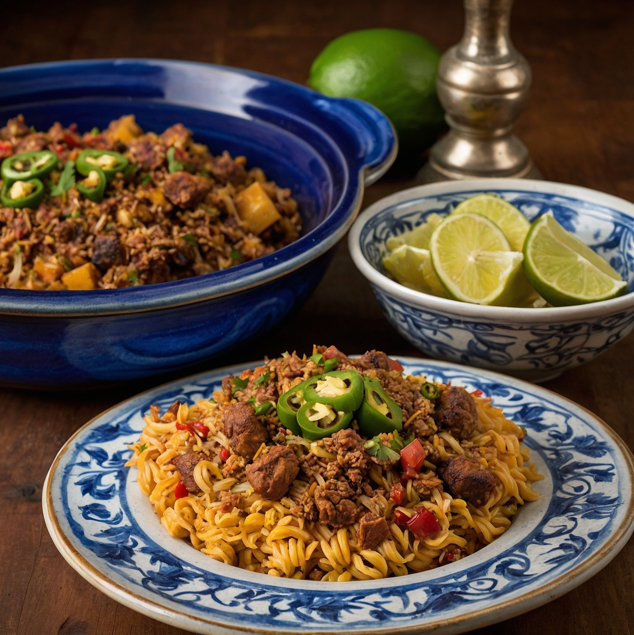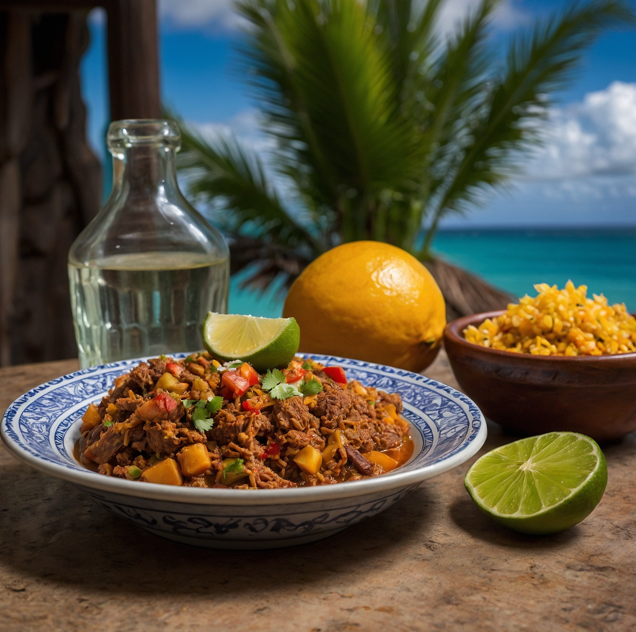Introduction to Puerto Rican Food Culture
Puerto Rican cuisine, or “Cocina Criolla,” blends Spanish, African, and Taíno influences into a rich, flavourful tradition. Every dish tells a story, drawing from a mix of indigenous ingredients, colonial imports, and creative local adaptations. Food in Puerto Rico is more than sustenance; it is a central part of celebrations, family gatherings, and the island’s communal spirit.
What is the Famous Dish in Puerto Rico?
When discussing Puerto Rican cuisine, one dish often stands out: Arroz con Gandules. Arroz con Gandules, Puerto Rico’s national dish, blends spices, pigeon peas, and sofrito, embodying its culinary identity.
The Origins of Arroz con Gandules
The roots of Arroz con Gandules can be traced back to the island’s colonial era, with influences from both Spanish and African culinary traditions. The introduction of rice and pigeon peas by the Spaniards combined with African cooking techniques gave rise to this cherished dish. Over centuries, Puerto Ricans adapted the recipe, making it their own with the inclusion of local ingredients and distinct flavour profiles. Today, Arroz con Gandules is more than just food; it is a symbol of Puerto Rican heritage and resilience. Learn more about how this dish symbolises the island’s spirit and its perfect pairing with sides like perfect-smoked-meatloaf-recipe-a-step-by-step-guide.
Traditional Ingredients Used
At the heart of Arroz con Gandules is a blend of simple yet flavourful ingredients. Key components include:
- Rice: The base of the dish, often medium-grain, which absorbs the flavours of the sofrito and spices.
- Gandules (Pigeon Peas): These legumes add a nutty, earthy taste that complements the seasoned rice.
- Sofrito: A traditional mix of onions, garlic, peppers, cilantro, and recao (culantro), which serves as the flavour foundation.
- Annatto Oil (Achiote): Used for its vibrant colour and subtle nuttiness.
- Spices: A mix of adobo, oregano, and sometimes a hint of cumin for depth.
Regional Variations of Arroz con Gandules
Although the core recipe for Arroz con Gandules remains consistent, regional variations reflect the diverse culinary practices across Puerto Rico. For instance:
- Coastal Areas: Recipes may include seafood such as shrimp or crab, giving the dish a coastal flair.
- Mountainous Regions: More rustic versions might substitute pork with other locally available meats or rely on fresh, foraged herbs.
- Urban Variations: Contemporary versions in cities might incorporate new ingredients like chorizo or even vegetarian substitutes for a modern twist.
Each variation reflects Puerto Rican cooks’ creativity, keeping Arroz con Gandules a cherished and evolving tradition.
What is the National Dish for Puerto Rico?
The national dish of Puerto Rico is Arroz con Gandules, a savoury and aromatic rice dish cooked with pigeon peas, pork, and a signature seasoning blend. This iconic recipe is a cornerstone of Puerto Rican culinary culture, symbolising the island’s rich heritage and community spirit. While mofongo and pasteles are iconic, Arroz con Gandules is Puerto Rico’s national dish for its popularity and cultural importance.
The History Behind Puerto Rico’s National Dish
Arroz con Gandules has deep historical roots, reflecting the fusion of Taíno, Spanish, and African influences that define Puerto Rican cuisine. Rice, introduced by the Spanish during the colonial period, became a staple ingredient, while pigeon peas, likely brought from Africa, added an earthy richness. Over time, the dish evolved with the addition of sofrito—a blend of local herbs and spices—and pork, reflecting the island’s agricultural practices and access to fresh produce. Each ingredient in Arroz con Gandules tells a story of cultural exchange and adaptation, making it a culinary time capsule of Puerto Rico’s history.
Celebrating Festive Occasions with Puerto Rican Cuisine
Arroz con Gandules is more than just food; it is a symbol of celebration and togetherness in Puerto Rican culture. It is a must-have dish during special occasions such as Nochebuena (Christmas Eve), weddings, birthdays, and family reunions. Often served alongside lechón asado (roast pork) and tostones (fried plantains), it forms part of a lavish spread that showcases the island’s love for flavourful and hearty meals. The communal preparation of the dish, often involving multiple generations, underscores its role in bringing families together and preserving traditions.
Cooking Techniques and Family Traditions
Preparing Arroz con Gandules is a cherished tradition, using sofrito, annatto oil, and gandules for its golden, rich flavour.
Family traditions play a significant role in the cooking process. Some families incorporate additional ingredients like olives, capers, or even coconut milk to create regional variations. Cooking methods also vary; while most households prepare Arroz con Gandules on the stovetop, others may use a traditional caldero (a thick, heavy-bottomed pot) to achieve the perfect texture—slightly crispy on the bottom, known as pegao. This crispy layer is a cherished delicacy, often fought over at the dinner table.
Arroz con Gandules delights with its flavour and unites Puerto Ricans, evoking home and rich culinary heritage.
What are 2 Appetisers from Puerto Rico?
Puerto Rican cuisine is famous for its appetisers, which are rich in flavour and perfect for setting the tone of a delicious meal. Two of the most popular appetisers are Tostones and Alcapurrias, both of which showcase the island’s creative use of local ingredients and culinary techniques.
Tostones (Fried Plantains)
Tostones are a beloved Puerto Rican appetiser made from green plantains. The plantains are sliced, fried, smashed into discs, and then fried again to achieve a crispy texture. They are typically seasoned with salt and sometimes served with garlic dipping sauce or mojo for an extra burst of flavour. Tostones reflect the island’s ingenuity in turning a simple ingredient into a versatile dish. Whether served alone, with a topping like shrimp, or alongside other dishes, tostones are a crowd-pleaser that perfectly balances crunch and savoury goodness.
Alcapurrias (Stuffed Fritters)
Alcapurrias are a classic Puerto Rican street food and appetiser, consisting of a deep-fried dough made from a mixture of grated yautía (taro root) and green bananas. The dough is filled with a savoury mixture, usually ground beef or crab, seasoned with Puerto Rican spices and sofrito. These fritters are then shaped into torpedo-like forms and fried until golden brown. Alcapurrias are cherished for their crispy exterior and flavourful, hearty filling, making them a staple at parties, festivals, and family gatherings.
Pair these with other classic dishes like the-ultimate-bbq-shrimp-recipe-smoky-juicy-and-irresistible to explore more of Puerto Rico’s diverse flavours.
Why is Puerto Rican Food So Good?

Puerto Rican cuisine owes its distinct taste to the use of flavourful spices like adobo and sofrito, combined with influences from Taíno, African, and Spanish cultures. These influences are similar to the intricate flavour profiles found in dishes like delicious-branzino-recipe-a-guide-to-preparing-this-mediterranean-delight.
The Role of Flavourful Spices
One of the reasons Puerto Rican food is so delicious is the liberal use of spices and seasonings. Sofrito and adobo, rich blends of herbs and spices, form the flavourful base of many dishes. The use of annatto seeds, cumin, and fresh cilantro further elevates the complexity of Puerto Rican cuisine. These seasonings ensure that every bite is an explosion of taste, with a perfect balance of savoury, spicy, and earthy notes.
Influence of African, Spanish, and Taíno Cultures
Puerto Rican food is a melting pot of cultural influences. Puerto Rican cuisine blends Taíno root vegetables, Spanish rice and pork, and African plantains, creating a unique culinary identity.
The Heart and Passion Behind Every Dish
What truly sets Puerto Rican food apart is the heart and passion that goes into every meal. Food is seen as an expression of love, a way to bring people together and celebrate life’s moments. Many recipes are handed down through generations, with families adding their unique touches to create personal versions of traditional dishes. Whether it’s a grandmother’s sofrito or a father’s lechón asado, each dish carries with it a story, a memory, and a connection to the island’s heritage.
Puerto Rican food is not only delicious but also deeply meaningful, making it an experience that goes beyond taste and nourishes both the body and soul.
Popular Puerto Rican Desserts
Puerto Rican desserts are a delightful blend of tropical flavours, rich textures, and cultural influences. Among the many sweet treats the island has to offer, two iconic desserts stand out: Tembleque and Flan de Queso. These desserts embody the essence of Puerto Rican cuisine—simple ingredients elevated by creative techniques and bold flavours.
Tembleque (Coconut Pudding)
Tembleque, meaning “wobbly,” is a silky coconut pudding made with coconut milk, sugar, cornstarch, and cinnamon. The pudding is cooked until thickened, poured into moulds, and chilled to set, resulting in a smooth, creamy texture. Topped with cinnamon or toasted coconut, Tembleque is a refreshing treat embodying Puerto Rico’s tropical charm.
Flan de Queso
this cheese flan made with cream cheese, milk, eggs, and baked in caramel for a luscious dessert. Flan de Queso is a favourite at family gatherings and celebrations, admired for its perfect balance of sweetness and creaminess. Its luxurious texture and caramel richness make it a truly indulgent experience.
No Puerto Rican meal is complete without dessert. Tembleque and cheese flan are delightful desserts to complete your culinary journey. Explore similar dessert ideas with this perfect-peach-crumble-recipe-a-delicious-dessert-delight.
FAQs
What is the Famous Dish in Puerto Rico?
One of the most famous dishes in Puerto Rico is Arroz con Gandules. This flavourful rice dish with pigeon peas, pork, and sofrito is a staple at Puerto Rican celebrations and gatherings.
What is the National Dish for Puerto Rico?
The national dish of Puerto Rico is also Arroz con Gandules, highlighting its significance in the island’s cuisine. This dish reflects the fusion of Taíno, African, and Spanish influences that define Puerto Rican food. Its simplicity, combined with a depth of flavour, makes it a cherished symbol of cultural pride.
What Are 2 Appetisers from Puerto Rico?
- Tostones (Fried Plantains): Tostones are crispy slices of green plantains that are fried, flattened, and fried again to perfection. They are often served with garlic dipping sauce or as a side dish, showcasing the versatility of plantains in Puerto Rican cuisine.
- Alcapurrias (Stuffed Fritters): These savoury fritters are made from a dough of grated green bananas and yautía (taro root), filled with seasoned meat or seafood. Deep-fried until golden, they are a favourite street food and appetiser.
Why is Puerto Rican Food So Good?
Puerto Rican food is renowned for its bold and irresistible flavours, which come from a blend of fresh ingredients, creative techniques, and cultural influences. Here’s why it stands out:
- Flavourful Spices: Key seasonings like sofrito, adobo, and annatto oil create a robust flavour base for most dishes.
- Cultural Fusion: The cuisine combines Taíno, African, and Spanish traditions, offering a unique mix of ingredients and methods.
- Heart and Passion: Food is seen as a way to bring people together, and every dish is prepared with love, reflecting the importance of family and celebration in Puerto Rican culture.
These qualities make Puerto Rican cuisine an unforgettable culinary experience.
Conclusion
Celebrating Puerto Rican Culinary Heritage
Puerto Rican cuisine is a vibrant celebration of the island’s rich history, cultural diversity, and boundless creativity. From the iconic Arroz con Gandules to beloved appetisers like Tostones and Alcapurrias, each dish tells a story of resilience, adaptation, and love for tradition. The blend of Taíno, African, and Spanish influences has created a cuisine that is not only flavourful but also deeply meaningful, connecting families and communities through food.
The dedication to using fresh ingredients, bold spices, and time-honoured techniques ensures that Puerto Rican dishes are as unforgettable as the island itself. As we explore and enjoy these recipes, we honour the passion and heritage that have made Puerto Rican cuisine a beloved culinary treasure around the world.

